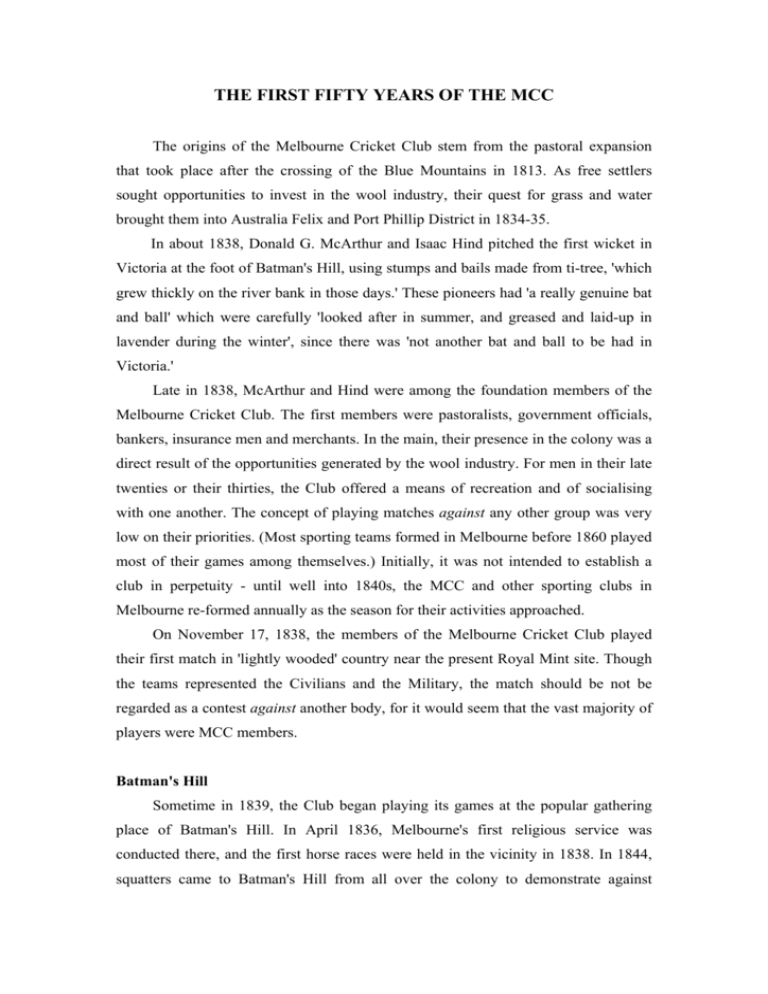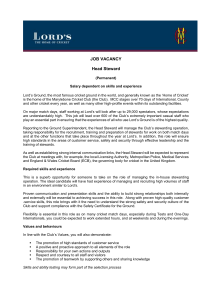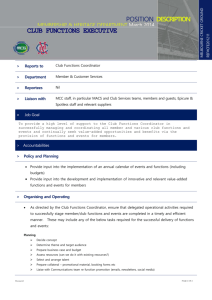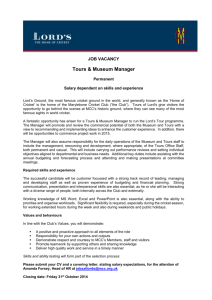Read more - Melbourne Cricket Club
advertisement

THE FIRST FIFTY YEARS OF THE MCC The origins of the Melbourne Cricket Club stem from the pastoral expansion that took place after the crossing of the Blue Mountains in 1813. As free settlers sought opportunities to invest in the wool industry, their quest for grass and water brought them into Australia Felix and Port Phillip District in 1834-35. In about 1838, Donald G. McArthur and Isaac Hind pitched the first wicket in Victoria at the foot of Batman's Hill, using stumps and bails made from ti-tree, 'which grew thickly on the river bank in those days.' These pioneers had 'a really genuine bat and ball' which were carefully 'looked after in summer, and greased and laid-up in lavender during the winter', since there was 'not another bat and ball to be had in Victoria.' Late in 1838, McArthur and Hind were among the foundation members of the Melbourne Cricket Club. The first members were pastoralists, government officials, bankers, insurance men and merchants. In the main, their presence in the colony was a direct result of the opportunities generated by the wool industry. For men in their late twenties or their thirties, the Club offered a means of recreation and of socialising with one another. The concept of playing matches against any other group was very low on their priorities. (Most sporting teams formed in Melbourne before 1860 played most of their games among themselves.) Initially, it was not intended to establish a club in perpetuity - until well into 1840s, the MCC and other sporting clubs in Melbourne re-formed annually as the season for their activities approached. On November 17, 1838, the members of the Melbourne Cricket Club played their first match in 'lightly wooded' country near the present Royal Mint site. Though the teams represented the Civilians and the Military, the match should be not be regarded as a contest against another body, for it would seem that the vast majority of players were MCC members. Batman's Hill Sometime in 1839, the Club began playing its games at the popular gathering place of Batman's Hill. In April 1836, Melbourne's first religious service was conducted there, and the first horse races were held in the vicinity in 1838. In 1844, squatters came to Batman's Hill from all over the colony to demonstrate against Governor Gipps' land regulations. In the same year, as tensions bubbled among Melbourne's Irish over the Orangemen's traditional celebrations of the battles of the Boyne and Aughrim, 'all colonists from the South of Ireland' were invited 'to attend in force at Batman's Hill ... to witness a county Hurling match for £50 between Clare and Tipperary.' Afterwards, 'footballing was (for the first time) introduced as an after piece.' As early as 1842, Superintendent La Trobe had plans for a 50-acre botanical garden to be established on the Hill. It was undoubtedly a beautiful spot. The chronicler 'Garryowen' says that the hills of Melbourne 'formed an immense cordon of she-oak, gum and wattle tree forests, which it could hardly be imagined would ever succumb to the fire and axe of civilization.' Further beyond Batman's Hill was the West Melbourne swamp. In 1841, George McCrae saw it as 'one of the chief beauty spots' of the region, 'a real lake, intensely blue, nearly oval, and full of the clearest salt water.' It was a haven for wildfowl, and the air was 'heavy with the mingled odours of the golden myrnong flowers and purple-fringed lilies.' In the 1840s. a strong rivalry developed between the MCC and the Brighton Cricket Club, formed in 1842. In 1845, Brighton thrashed the MCC three times. One of these matches merits some consideration. On April 26, after dismissing Melbourne for 57, Brighton scored 74. Brighton's 17-run lead was enough for an outright win. In the Club's worst-ever performance, the MCC team was all out for 10. By then, the beauty of the Batman's Hill area had been destroyed by abattoirs and fellmongeries. For the Melbourne Cricket Club, the final straw appears to have been LaTrobe's decision in 1846 to build a powder magazine overlooking the ground. It was time to move. Southbank From October 1846, the MCC played near what is now the site of Crown Casino. It was an attractive location, with the Yarra flowing between lovely green banks shaded by gum trees. In 1836, John Pascoe Fawkner had sown 30 acres of wheat, oats and barley there. (Contrary to popular belief, this was not Melbourne's first crop - Fawkner had earlier sown land on the north side of the Yarra.) The move to what is now Southbank ended the Club's practice of re-forming at the approach of the cricket season. The MCC had no title to the land it occupied - in the parlance of times, the Club had simply 'squatted' on the site. To convince the government of its credentials to stay, the Melbourne Cricket Club re-constituted itself in 1846. From that point, the members intended that their Club would exist on a perpetual basis. A new list of foundation members was published and for at least the second time a set of Club rules was published. It was at this new 'playground' that the term 'Melbourne Cricket Ground' was first used. The move to Southbank was no doubt also influenced by the opening of a wooden bridge in 1845. Each evening, the bridge was crowded by cows being driven back into Melbourne from the common on the south side of the Yarra. In 1847, MCC began playing occasional matches against Geelong. Then, in 1851, a match was played in Launceston. This encounter is now regarded as the inaugural first-class match in Australian cricket. In March 1852, the Tasmanians played Victoria on the Melbourne Cricket Ground at Southbank or, as it was termed at the time, 'South Yarra'. However, by the early 1850s, if not before, the Club had become dissatisfied with its home. The area was prone to flooding - in November 1849, for example, the Yarra rose 37 feet, and the Ground was swept by a flood while a match was in progress. Early in the gold rush, the notorious 'Canvastown' was established alongside the Club's Ground. It was a lawless, disease-ridden place, peopled by the floating population moving to and from the diggings. In 1853, the prospect of the railway line to Port Melbourne skirting the ground sparked the MCC's decision to move. The tale that the line ran through the middle of the Ground is hard to accept, for the site continued to be used by the Emerald Hill Cricket Club until the 1860s. The Richmond or Police Paddock In the late 1830s, high land prices in Melbourne had forced many intending land owners out to Richmond. In 1852, MCC Member William Howitt described that area as 'an immense suburb stretching parallel with the town ... all covered with thousands of little tenements ... a wilderness of wooden huts.' Richmond was separated from the eastern edge of Melbourne by a broad band of undulating, well-timbered bushland. In 1838, 300 acres of this had been fenced off to form the Richmond or Police Paddock. As the Melbourne Cricket Club sought a new home in 1853, its attention was drawn to the Paddock, probably because some cricket had already been played there late in 1852. In September 1853, Lt-Governor Latrobe signed a grant enabling the Club to take up 10 acres for five years. The site selected was buffered from city by LaTrobe's own 20 acres and the reserves set aside for government buildings and parks. To establish its new home, the Club had to have huge redgums and hundreds of tons of bluestone removed. One of the labourers recalled that 'crusty old devils' of trees had to be shifted by blowing up the trunks [and] the wood carted ... off and burnt.' It would take more than 20 years before Ground's surface resembled the smoothly-grassed arena we know today. The first match was played on the site of the present Melbourne Cricket Ground on September 30, 1854. It was a contest between teams of members led by William Philpott and George Cavenagh, editor of The Herald. The players used their new Pavilion, located at what is now the western edge of the Olympic Stand. In fact, it was situated at the closest point to the Parade Hotel which handled the Club's catering. In March 1856, a Victorian Eleven played NSW on the MCG. Years later, the Sydney batsman and under-arm bowler Harry Hilliard recalled that The Melbourne Cricket Club ground was very different to its appearance at the present day. There was no grass on it; iron hurdles were placed round the ground to keep out the non-paying portion of the public. The ground was indeed 'very different': the cattle from the Richmond Paddock would occasionally break through the hurdles, 'and after taking their fill of clover, quietly compose themselves to rest on the best wicket-ground.' In addition, 'erratic goats used to camp in the pavilion, and a flock of sheep was no unusual sight from the verandah.' The week after Christmas 1861 was the most exciting the Ground had seen. For three days, the MCG was used for the Caledonian Games, which culminated in football, cavalry exercises and the Coeur de Lion feat, in which horsemen attacked sheep carcases with swords. Then, on New Year's Day 1862, the Eighteen of Melbourne and Districts played H. H. Stephenson's All-England Eleven. The tour, organised after two years of negotiations, was promoted by Felix Spiers and Christopher Pond who operated the Cafe de Paris in Bourke Street. A temporary grand stand - the second of at least half a dozen temporary stands built at the Ground between 1860 and 1884 - was 800 feet long, with accommodation for 6000. The presence of 15000 spectators on the first day, with at least another 10000 outside the Ground, meant that, for the first time, a cricket match in Melbourne rivalled in interest and excitement the annual racing carnival which had been held at Flemington since the 1840s. For Spiers and Pond, the match - and the tour that followed - brought enormous profits, reputedly in excess of £10000. In 1862, after their success as cricket entrepreneurs, they offered Charles Dickens £10000 to undertake a lecture and reading tour. After much indecision, Dickens declined, basically because he did not want to leave his mistress Ellen Ternan. The tour came at the height of colonial Victoria's vigour and enterprise. When a second English team visited in 1863-64, the Burke and Wills debacle had heralded a downturn in the colony's energy and optimism. This outlook was certainly reflected in colonial cricket, for a mood of lethargy appeared in the game. Melbourne Cricket Club teams became notorious for showing up late - against East Melbourne in 1866, they didn't appear at all. At the time, some journalists put part of the blame for the situation on the state of the MCG. At the end of the 1860s, 'Old Chum' argued that the wickets were so poor because the Club had acquired a new-fangled grass cutting machine, which could only produce 'bumpy wickets to play on ...' He thundered: Will the M.C.C. committee ever see their error in using that stupid machine? Far better was the way that 'the brawny Scot' at East Melbourne prepared his pitches: He has no machine to bruise his grass, and no horse to draw his roller; but he can be seen, scythe in hand, from morn till eve; and should the ground require to be rolled, he has to yoke himself to the great stone roller; and yet I guarantee there are no better wickets to be got than on the East Melbourne ground at the present time. One other MCG development troubled 'Old Chum'. From 1860, three years after the opening of the Yan Yean reservoir, the groundsman had water on tap. 'Old Chum' complained that pitches became far too easy for batsmen, as the ball no longer 'cut about all ways' but kept its course. By the late 1860s, the MCC's finances were so weak that the Club seriously flirted with athletics as the main reason for its existence. Despite a vote against the idea, a running rink was built around the Ground, but poor attendances and rows over professional athletes meant that athletics did not bring the anticipated rewards. The cricket revival came in 1873-74, when a consortium of cricket enthusiasts, including several MCC members, brought out team led by W. G. Grace. The tour was not a happy one, but the prospect of more England tours encouraged the MCC, under the leadership of its President, David McArthur, to take a crucial decision. The Club decided to rebuild its finances by providing the best facilities for the public - a permanent grandstand capable of holding over 2000 spectators. ***** Before considering that development, it is necessary to examine the history of football in the colony and on the Melbourne Cricket Ground. The earliest evidence of football in Victoria seems to be the match at Batman's Hill in 1844. In 1850, football was played opposite the White Hart Hotel at the top of Bourke Street and at Flemington Racecourse. Another match had been played on the Club's Ground at Southbank during the Separation celebrations of November 1850. In July 1858, MCC Secretary Tom Wills wrote a letter to Bell's Life in Victoria suggesting the formation of a football club or a rifle club to keep cricketers active in winter. Wills was not suggesting a radical new form of football - and certainly not the game we know today. Instead, the pioneers of 1858 built on the traditions of the game that had already been played in Melbourne and in the English public schools. I have found no evidence to indicate that Wills was writing on behalf of the Melbourne Cricket Club or even in his capacity as Honorary Secretary of the Club - if he were, he would surely have put forward his proposals at a Committee meeting and not in the press. Further, I have found no hard evidence that the MCC had any interest whatever in football or in the formation of a football club. While the 1858 Committee Minutes have disappeared, the Melbourne press does not make any connection between the Melbourne Cricket Club and the rise of football. The MCC Minutes of 1859 and after do not refer to the Club having any involvement in football, apart from making the Ground available on odd occasions for matches. Rather, the letter has to be viewed as the expression of a private viewpoint which quickly gained the endorsement of many MCC members and others. If Wills did have any particular ends in mind with his proposals, it was more likely as captain of the Victorian Eleven. Within weeks of the Wills letter, it would seem that the MCG was being seen as a venue for football, mainly through James Mark Bryant, the Ground's 22-year-old caretaker. In these seminal days of football, it was Bryant, more than Wills, who provided much of the momentum for the game's growth. When 'a number of gentlemen ... determined upon getting up a football club', Bell's Life In Victoria announced on Saturday July 31, 1858, that Mr. Bryant ... on the principle that 'an ounce of practice is worth a pound of theory,' will have a ball on the Melbourne cricket ground, or adjoining portion of Richmond Park, to-day, at one o'clock. A week later, Bryant was among the adults who played in the match between Scotch College and Melbourne Grammar. As proprietor of the Parade Hotel, Bryant's interests probably extended beyond the altruism of fostering the game to the more practical hope that the footballers might be encouraged to sample the wares of his counter. Whatever his motives, Bryant's sporting inclinations and his hostelry served as a focus that drew those seeking winter recreation to the Paddock. There, on most Saturdays of July and August 1858, 'pedestrians', as the early players were known, would take part in scratch matches. In 1859, Melbourne played two matches against South Yarra on the Melbourne Cricket Ground. 'which is to be roped off for the occasion, and the Pavilion will be appropriated to the use of the fair sex.' A year later, Melbourne played Richmond on the Ground. However, from then until 1877, only five football matches were played on the MCG. While this has usually been interpreted as the MCC jealously guarding its sacred turf for cricket, the Club's Minutes do not support that interpretation. The MCC had little objection to football on its Ground, but usually required those using the MCG to pay for the privilege. For the early football clubs, this was difficult, as they earned little or nothing from attendances. The main reason that the Ground hosted few football matches was that the ground staff was engaged every winter on major works, such as resurfacing, levelling, installing pipes and building embankments for crowds. At times, the 'sacred turf' of the MCG was even used as a dump for Melbourne's nightsoil. Further, the neighbouring Melbourne Football Club had no connection with the MCC, other than using its Pavilion as a dressing room. The MFC had no desire to leave its own ground, located just to the north of the MCG. Throughout the 1860s, Melbourne attracted crowds of several thousand to its matches in Yarra Park. Since the Melbourne Football Ground was on council land, the MFC was unable to charge for admission. When the Melbourne Cricket Club built their permanent grand stand in 1876, football in the Park represented a means of raising money for themselves. The architect George Browne had come up with an ingenious idea for reversible seating, which would enable the MCC to charge admission to its stand inside the MCG during matches on the Melbourne Football Ground. Before this scheme could be put into practice, the MFC requested permission to play one match on the Melbourne Cricket Ground, with the intention of raising money to improve the state of their decaying football ground. This 1877 match against Carlton was one of the most important football matches ever played. While large crowds had attended football before, the phenomenon of 2000 congregated in a stand was still quite new. The result was an atmosphere unlike anything that journalist 'Peter Pindar' had experienced: The excitement among the onlookers themselves, especially for the last half hour, was greater than ever I have seen at a football match, and the shouting and cheering, like 'the sound of a rushing mighty wind,' or 'the noise of many waters,' something to be remembered. Adding to the uniqueness of the occasion was the decision not to play on the usual rectangle - instead, 'the entire cricket-ground circle' was used, giving 'every man a larger area to cover ...' The result was a more open 'friendly give-and-take style of play', with little of the usual roughness. By eliminating the problems usually caused by football crowds encroaching on to the playing area, this match on the fenced MCG reinforced the trend to enclose playing fields. In 1878, the East Melbourne, South Melbourne and Corio Cricket Clubs followed the MCC's example and opened their grounds to football. That year, eight matches were played on the Melbourne Cricket Ground. More were played in the following years, but the Ground was always closed to football after July, so that the surface could be prepared for the cricket season. While football provided the MCC with growing financial security, the new stand had to be filled on a year-round basis. At the same time, the Club intended to commit itself to another heavy financial burden by replacing the original 1854 Pavilion. For these reasons, the Club started organising tours by English cricket teams, with a team led by Lord Harris coming out in 1878-79 and another under the Hon. Ivo Bligh in 1882-83. The financing of the stand and new Pavilion was done through sale of debentures. The heavy burden of paying these off was not seen as a problem, since the Ground was being regularly used for cricket, football and cycling. (By the 1890s, the MCC took little profit from these, returning most of the takings to the organising bodies.) The high number of events at the Ground produced a large growth in membership which in turn provided a substantial and regular income. (Thus, contrary to legend, the Club did not face ruin in the Depression of the 1890s.) Most of the members joining the MCC did so to watch matches in comfort and for the social status membership conferred. Even so, there were still solid numbers wanting to play. Cricket matches were arranged for all levels of ability, from the highly talented to those with minimal skills. By the end of the 1880s, the Club was fielding about seven teams. In addition, well over a hundred members were attracted to the Club by the asphalt 'lawn tennis' courts which the MCC installed at the western end of the Ground. More than any other organisation, the Melbourne Cricket Club was responsible for the establishment of lawn tennis competitions in Victoria, holding its first tournament in 1879, only two years after Wimbledon. By 1884, the Melbourne Football Ground was in a very poor state. In fact, Melbourne did not use it that year, and the City Council was not anxious to see improvements made. Consequently, the reversible stand was not turned during that winter. It was destroyed by fire shortly before the 1884-85 cricket tour organised by English professionals Shaw, Lillywhite and Shrewsbury. For that summer, a temporary stand, seating nearly 2000, was built between the arena fence and the site of the burnt-out stand. A new grand stand, 100 yards long, was built in 1885, and extended a dozen years later. Under the leadership of its President, Frank Grey Smith, and its Secretary, Major Ben Wardill, the Club placed considerable emphasis on the notions of fostering cricket and of playing the game in the right spirit. In 1886, the MCC sent an Australian team to England. In 1887-88, the Club persisted with its plan to bring an English team to Australia, even after Lillywhite, Shaw and Shrewsbury announced that they were bringing a team as well. The MCC's tour lost a massive £3582, but, in order to resist professionalism, Grey Smith and the Committee were prepared to accept that loss. Grey Smith later said that the Club had had attributed to it a desire to control Australian cricket. He had never heard any suggestion that the club should vaunt itself into such a position. He had seen it suggested somewhere that as soon as the Melbourne Cricket Club had succeeded in getting control of Australian cricket, as it wished to do, the 'death-knell' of other clubs in Victoria would have been sounded. It struck him that if the Melbourne Cricket Club annihilated all the other clubs, it would have gone a long way to destroy its own prosperity. In the 1900s, the Club's role in the game would be at the forefront of a dispute that would bitterly divide and re-shape Australian cricket. Alf Batchelder







